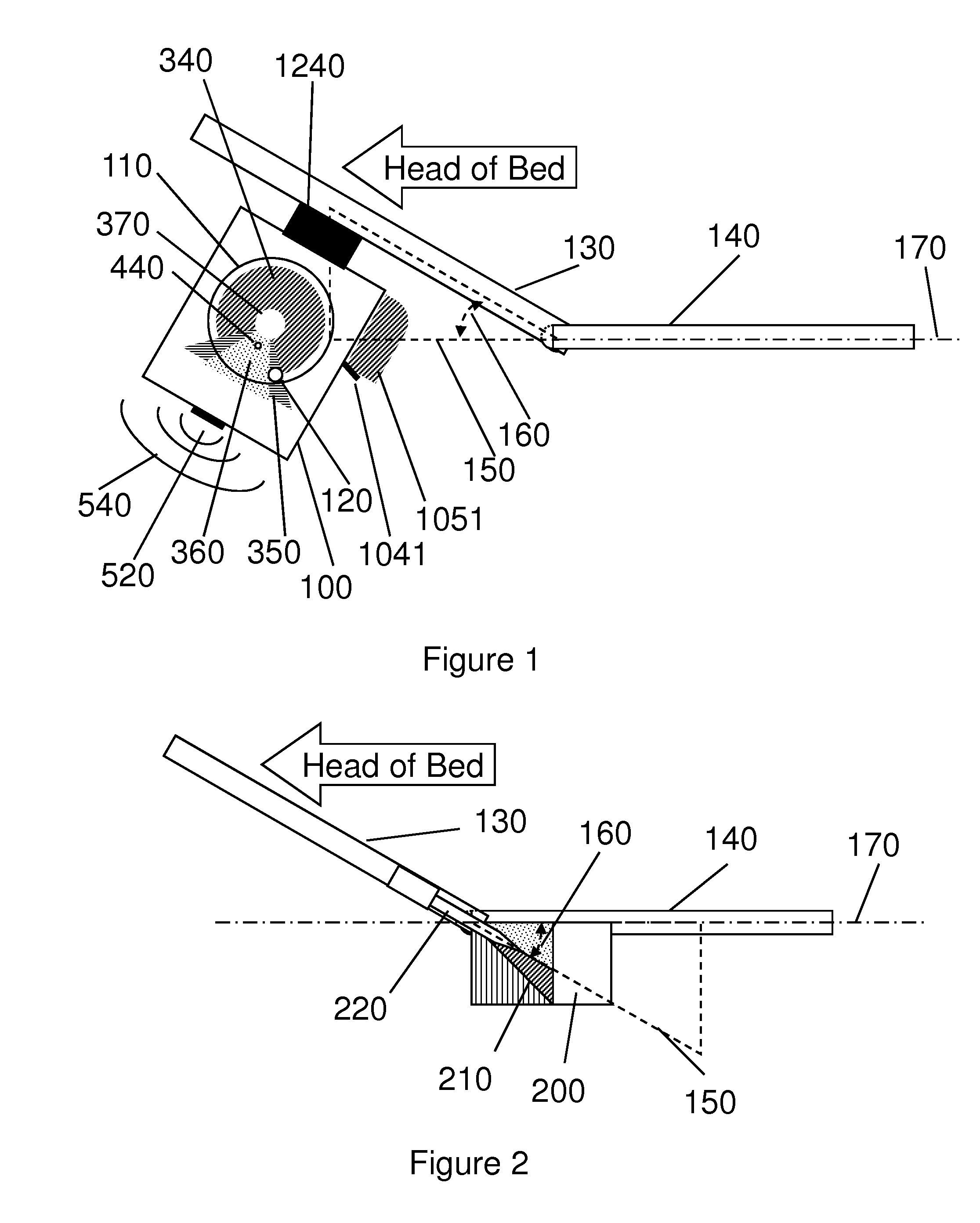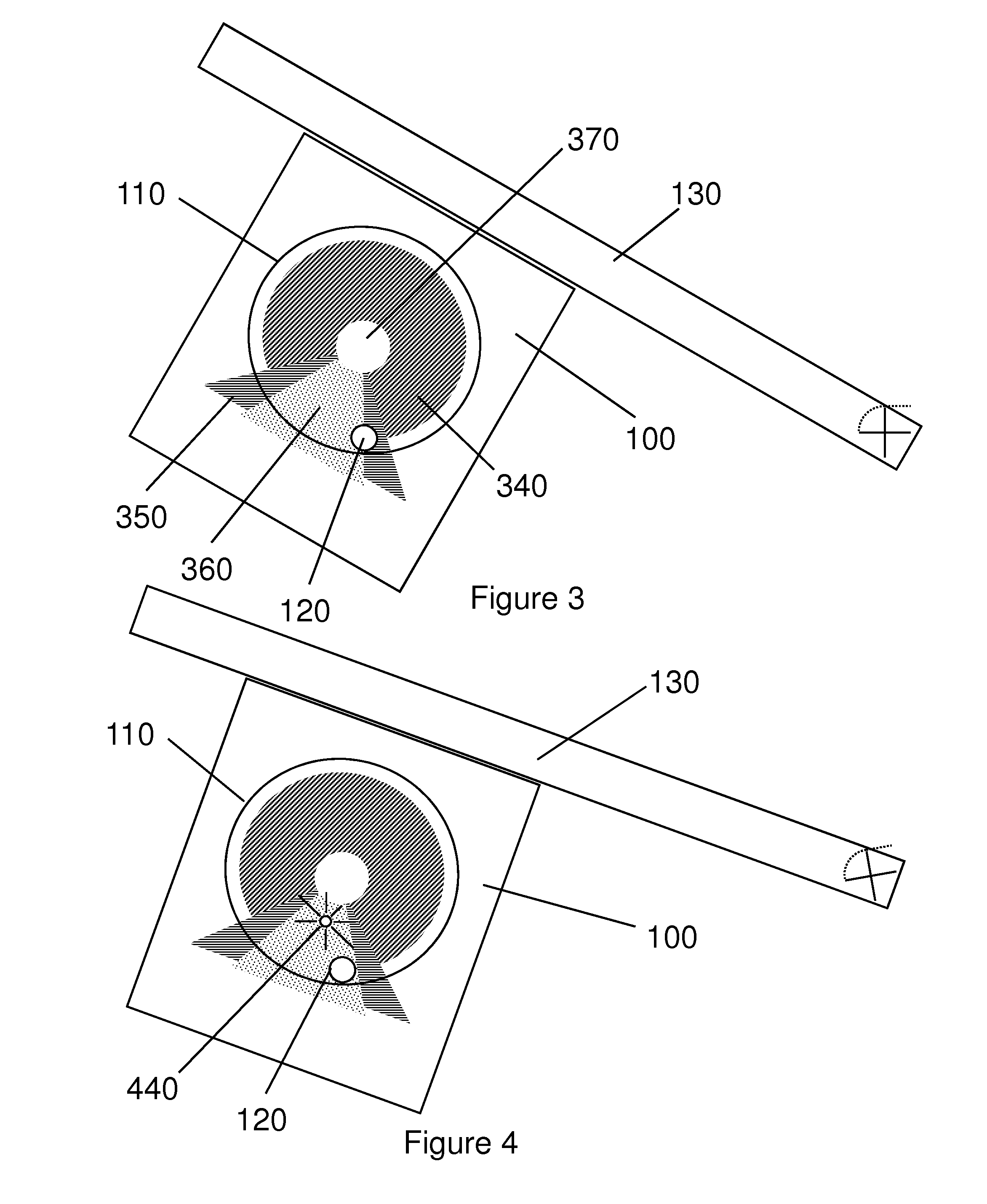Device to reduce the incidence of aspiration
a technology of aspiration and a measuring device, which is applied in the direction of fluid mattresses, instruments, applications, etc., can solve the problems of unreachable 30 to 45 degree elevation restoration, increased risk of patients, pneumonia, respiratory arrest, etc., and achieve the effect of preventing unintentional power down of the devi
- Summary
- Abstract
- Description
- Claims
- Application Information
AI Technical Summary
Benefits of technology
Problems solved by technology
Method used
Image
Examples
second embodiment
[0049]Referring to FIG. 2, the invention in the form of a goniometer includes an annunciator that is preset to indicate the required angular positioning boundaries of the patient. Goniometer 200 is attached to the lower portion or foot of bed 140. The bed also has a moveable upper portion or head 130. Local horizontal is indicated by broken line 170. It is assumed that broken line 170 is perpendicular to the local gravity vertical. Angle range indicator 210 in combination with pointer 220 indicates the angle of the upper portion of bed 130 (i.e. angle 160 in triangle 150) and functions as goniometer 200. Other methods of measuring the angle of head of bed 130 could utilize an existing angle measuring device on the bed coupled with an attached scale that indicates the proper elevation of head of bed 130. Appropriate angular ranges 160 of the upper portion of bed 130 that reduce aspiration in the patient are indicated on the face of goniometer 200.
third embodiment
[0050]Referring to FIG. 3, the invention in the form of the inclinometer utilizing a passive visual indicating device includes various indicators to indicate wither the unit is in or out of angular compliance, the operational status of the unit (e.g. battery condition or power switch position), and actual angle of the device or other data parameters of the device. The passive angle indication method may comprise of a needle indicator, colored windows, passive bubble (i.e. spirit level) level, floating indicator level, a manometer tube set, a pendulous (e.g. plumb bob) mass, a ball on an arcuate surface (e.g. ball in tube) or any other known method of indicating the desired elevation of the patient's upper torso including the use of a goniometer. FIG. 3 shows inclinometer 100 with ball 120 in transparent arcuate assembly 110. Ball 120 tracks the local vertical. Fastener 370 holds transparent arcuate assembly 110 to inclinometer 100 face. Inclinometer 100 is fastened to the upper move...
fourth embodiment
[0051]Referring to FIG. 4, the invention in the form of the inclinometer utilizing an active visual indicating device includes various signal lights or alphanumeric displays (e.g. incandescent light, light emitting diode, laser, IR LED, OLED, electro luminescent panel, fluorescent lamp, LCD or any other known light emitting or light altering method) operating in various modes (e.g. continuously on or flashing) to indicate wither the unit is in or out of angular compliance, elapsed time in or out of angular compliance, the operational status of the unit (e.g. battery condition or power state), actual angle of the device or other data parameters of the device including the application to the goniometer version. FIG. 4 shows inclinometer 100 with ball 120 in transparent arcuate assembly 110. Ball 120 tracks the local vertical. Inclinometer 100 is fastened to the upper moveable portion of bed 130. Active angular indicator light 440 on the face of inclinometer 100 flashes when the inappr...
PUM
 Login to View More
Login to View More Abstract
Description
Claims
Application Information
 Login to View More
Login to View More - R&D
- Intellectual Property
- Life Sciences
- Materials
- Tech Scout
- Unparalleled Data Quality
- Higher Quality Content
- 60% Fewer Hallucinations
Browse by: Latest US Patents, China's latest patents, Technical Efficacy Thesaurus, Application Domain, Technology Topic, Popular Technical Reports.
© 2025 PatSnap. All rights reserved.Legal|Privacy policy|Modern Slavery Act Transparency Statement|Sitemap|About US| Contact US: help@patsnap.com



